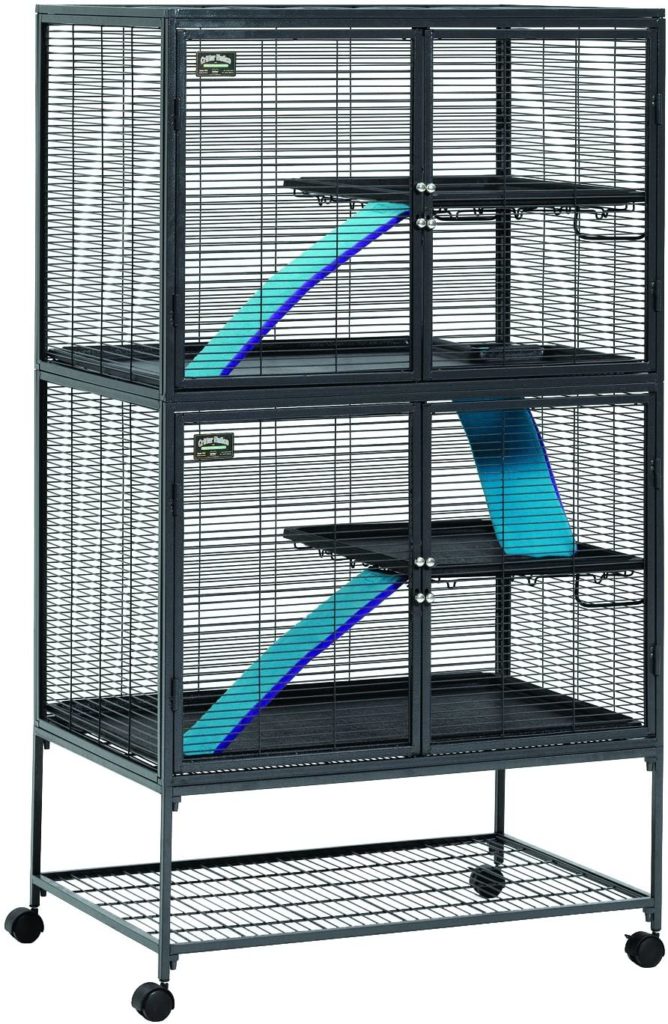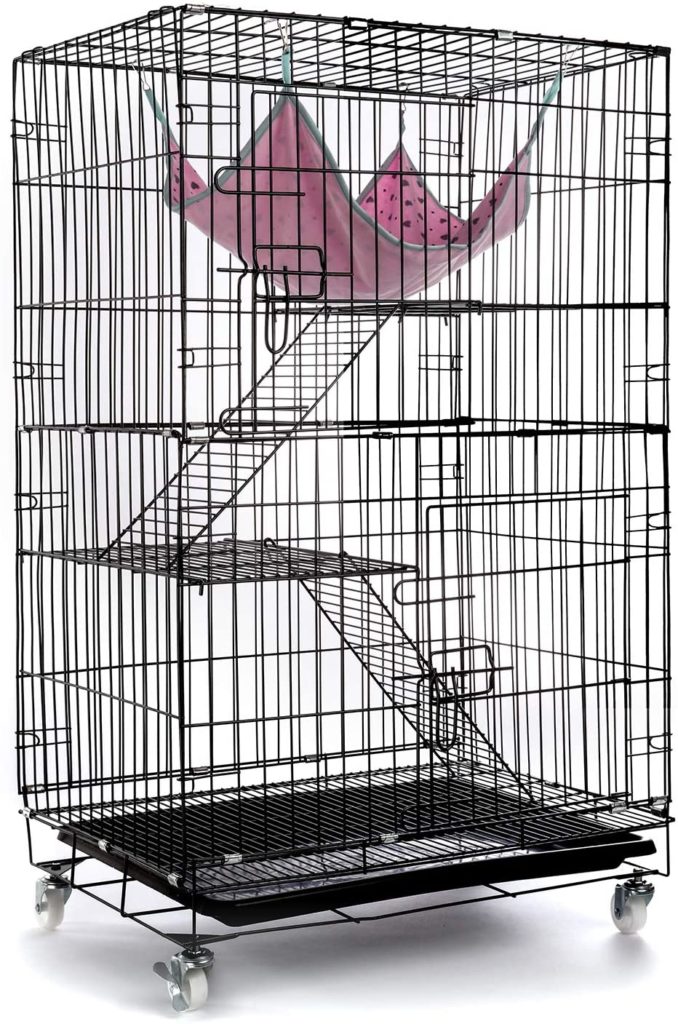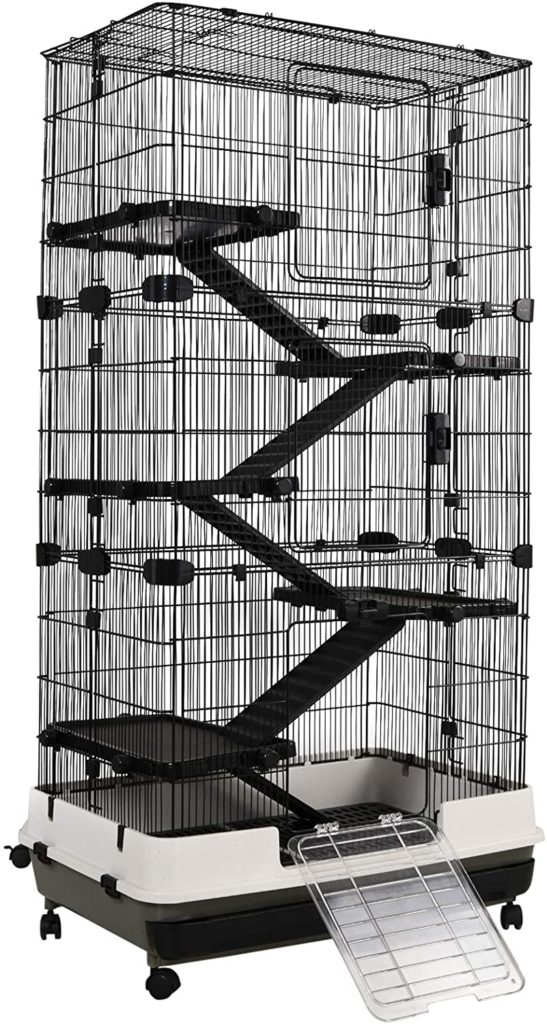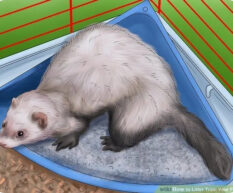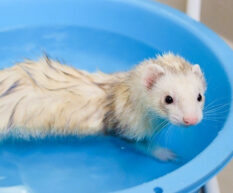Ferret News
Top 3 Ferret Cages for Your Weasel (and Tips for Setup)
By Jazmin "Sunny" Murphy
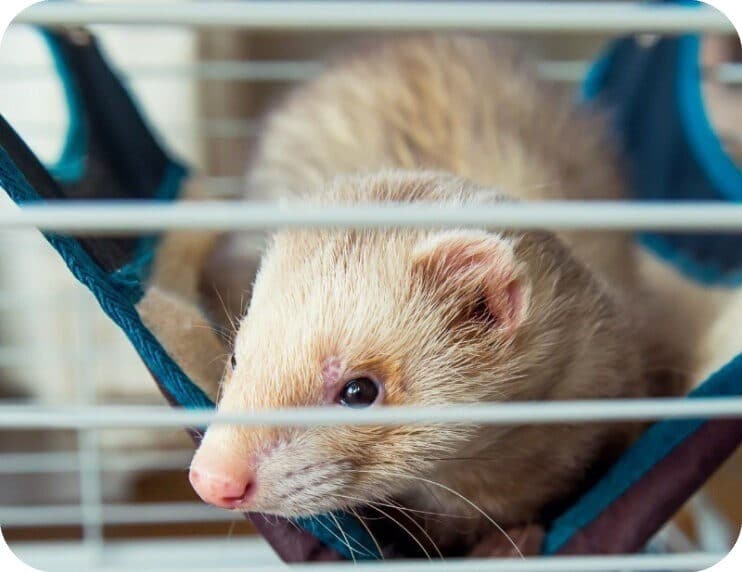
Your ferret’s cage is critical to its health and safety. When it’s not running amok in the house or yard, the cage is your ferret’s primary shelter, its “safe space.”
That said, one of the best ways to provide a fulfilling life for your ferret is to invest in a high-quality enclosure. This in-depth overview of what to look for in a ferret cage, plus shopping and setup tips, will help you do just that.

What makes a good ferret cage?
Ferrets are wily little critters that need secure housing to stay safe and out of trouble. Most ferret owners see cages as the most secure enclosure, as opposed to hutches or playpens. With a ferret cage, you won’t have to constantly supervise your pet or worry about its inquisitive nature leading to sneaky escapes.
Plus, an appropriately sized cage will provide your ferret with enough room to entertain itself, even if you’re away or sleeping. The proper dimensions (discussed below) will allow the perfect amount of space for the little weasel to scuttle about its enclosure just as it would your home.
Additionally, these pets’ inclination to chew on things is critical to consider when choosing adequate ferret housing. Ferrets with pent-up energy are liable to gnaw their way out of cages. With that said, you must prioritize durability in your cage shopping.
You’ll also need to consider the number of ferrets you’re housing and whether you prefer to keep the sexes separate when raising multiple pets.
Surprisingly, males tend to get along better than females, but only when introduced gradually and carefully. In any case, it’s best to ensure that each ferret has enough room to feel comfortable, as if the cage were its own, with adequate sleeping, feeding, and potty space.
There are numerous factors to evaluate about a cage before committing to a purchase. While some of these come down to preference, there are a handful of non-negotiable elements that could significantly influence your ferret’s health and wellbeing.
Critical ferret housing factors
There are three crucial standards that a ferret cage should meet pertaining to dimensions, material, and ventilation.
Contrary to popular belief, these are not mere matters of preference. They directly impact your ferret’s hygiene and health, as they allow waste material to fall into a cleaning pan and prevent the accumulation of ammonia by letting breezes blow through.
Here’s are some critical factors to consider when shopping for a ferret cage:
- A ferret’s cage should be at least 60 x 60 x 45 cm (about 24″ x 24″ x 18″). There should be enough space inside for bedding, exercise, feeding, and a litter box. Your ferret should not be cramped or uncomfortable when lying, sitting, or moving around in its enclosure.
- The best material for a ferret cage is either hard plastic or metal. Recall that ferrets like to chew on things. That said, there’s a good chance it might destroy anything less durable than metal quite easily. Rick Axelson of VCA Hospitals notes that wooden housing material is not a good idea, as it’s prone to absorbing urine and feces and impossible to disinfect.
- Concerning ventilation, it’s best to avoid glass enclosures and terrariums when shopping for ferret housing. These options dramatically increase the risk of your ferret overheating or inhaling excessive ammonia since there is no airflow to release the gases expelled by decaying waste.
- Note: This is yet another reason why metal wire cages are the safest option for housing ferrets. It allows for better temperature and air quality regulation, a critical factor, given that ferrets can’t typically handle temperatures over 32°C.
No matter what cage you choose, you must ensure that your ferret is potty trained. These pets have a habit of relieving themselves in the corners of their cages. So, without proper training, waste might get trapped in hard-to-reach places. Providing a litter box with shredded paper (not cat litter!) will help prevent this issue.

Do ferrets need a lot of space?
Face it: Your ferret’s not always going to be in its cage. To keep it happy and healthy, you’ll need to let the little weasel run around the house for at least four hours daily. This will provide enough exercise to keep it fit and run off enough energy to reduce antsy behavior in the cage.
Still, whether your ferret’s inside its cage or out, it’ll need lots of space. For those times outside the enclosure, you’ll want to give your ferret as big of a play area as possible.
Your best bet is probably a bedroom. Why? Although living rooms tend to be more spacious, the relatively large square footage hinders your ability to control the ferret’s movement. Since a bedroom is likely smaller and probably has less foot traffic than a living room, it’s the best option for letting a ferret run free.
(However, if you need to let a ferret run around freely in a large space like a living room, it’s best to invest in a playpen. This way, your ferret has a designated space to exercise without the risk of being stepped on or otherwise injured.)
Still, you and your ferret might not be satisfied with indoor playtime. For those who want their ferrets to get some fresh air outside, consider leash training.
Your fur-baby will most certainly love to walk around outdoors, feeling the breeze and hearing the birds. Even if you don’t have time to walk your ferret now and then, you can build or invest in an outdoor ferret house. In these enclosures, your ferret can sit peacefully outdoors without the risk of running off or being hurt by local wildlife.
Is it safe to keep your ferret outside?
You might also consider the option of housing your ferret outside. Some ferret owners prefer this alternative, as they may be pretty sensitive to their pets’ smell.
Housing ferrets outside is more typical for owners in the United Kingdom since the climate makes it more comfortable for them to live outdoors instead of inside. Ferret owners elsewhere should consider all the potential risks of keeping them in such settings:
- Check the weather regularly to avoid exposing your ferret to extreme temperatures.
- Watch out for predators. Suppose you live somewhere like Australia or the United States. There are lots of creatures to be mindful of in these areas, such as snakes and coyotes, respectively. Fortify their housing to keep them safe.
- Make sure your ferret can’t escape. This is even more important when your ferret is outdoors. If it gets out, there are far more dangers outdoors than in the house.
How do you proof a ferret cage?
Your house isn’t the only thing that needs to be ferret-proofed. Your ferret’s “house” needs to be secured, too.
As mentioned earlier, ferrets tend to escape from their cages (or they’ll try, at least), even if they’re happy and well-exercised. So, you’ll need to make sure the enclosure can stand up to its antics. Here are some issues to prioritize when proofing your ferret cage:
- Make sure your ferret can’t get tangled in its toys. Rope toys are fun to play with for your ferret, but if they’re too narrow, the ferret could become entangled and lead to choking or bodily injuries.
- Check for structural integrity. Ensure that all the cage platforms are structurally sound and that your ferret cannot fall from them and hurt itself. There should also be enough platforms in the cage that your ferret can’t fall too far and get injured.
- Verify that your ferret’s food and water bowls are secure. Having a secure water bowl is especially important since an accidental spill on their paper bedding or food could lead to bacterial growth if it’s not cleaned up.
- Escape-proof the cage. Of course, you need to ensure that your ferret cannot escape from its cage. This means that you should ensure that the wire spacing is not too wide (so they can’t squeeze through) and that your ferret can’t open any of the doors. This may require locks and latches.
The top 3 best ferret cages for your fur-baby
You’ve got quite a few things to think about when selecting the right cage for your fur-baby. These examples of top-of-the-line cages will help perfect your criteria when shopping for your ferret’s housing.
Make the dream home your ferret deserves with this customizable Midwest deluxe enclosure. This model is available in single-story and two-story designs, so you can set it up to house one or more ferrets comfortably.
This cage measures 36″ x 24″ x 63″, far exceeding the minimal requirements for a roomy ferret enclosure. It’s a pretty hefty cage, though, weighing in at 107 lbs, so be sure to have someone available to help you unbox and set it up upon delivery.
The deluxe critter cage comes with:
- 2 pans, perfect for keeping the cage hygienic while you’re cleaning the dirty pan
- 2 adjustable shelves, allowing personalization of your ferret’s enclosure
- 3 plastic ramps, connecting each platform for ease of traversal
- 3 ramp covers, providing traction for ferret’s toes
- 4 locking wheel casters, helping you move the gigantic cage strain-free
When it’s time to let your ferret run around the house freely or take the little weasel for a walk, the double doors will ensure an easy time getting it in and out of the cage.
But don’t forget about cleaning time. It’s a pain when you have to fight the dang trays to get them out of the cage for scrubbing. Thankfully, the removable shelves are made with busy ferret owners in mind, optimizing ease of removal (with the bonus of leak-proof pans).
Plus, the horizontal wiring ensures that your ferret can indulge its climbing instinct and crawl around the cage as it pleases. The tubing on the corners will help keep your pet safe, even when it gets a little rowdy.
Still, platforms and ramps aren’t enough. You need to add a little pizazz to your ferret’s cage and spice it up with beds, toys, and feeders. Luckily, the enclosure has multiple attachment points for accessories like hammocks, toys, and more. So, you can arrange your ferret’s favorite items in a way that best accommodates its unique habits and preferences.
Whether you’re away or sleeping, you won’t have to worry about your ferret in this cage. It’s equipped with dual-locking door latches that your pet can’t weasel its way out of. So, you can rest assured that your ferret’s safe and in its place, whether you’re away or not.
Even the most curious ferrets will be safe and secure in this Midwest deluxe critter enclosure. Whether you care for one or more of these pets, this single- or two-story cage could be a good choice for you.
What Ferret Owners Are Saying
This cage has received over 7,800 reviews and has managed to achieve a 4.5-star rating. Ferret owners have praised it as a “very well-made cage,” allowing for easy cleaning, ample space for their fur-babies, and painless assembly.
Still, the feedback isn’t all good. For instance, some customers were pretty upset about the assembly. Some claimed that it took much longer than expected to put the cage together, taking hours due to poor alignment, in a few cases.
Overall, though, most people were happy with their purchase and highly recommended this enclosure for your ferret.
Pros:
- Plenty of space for one ferret, measuring 36″ x 24″ x 63″
- Most people say it’s easy to assemble
- Convenient cleaning, thanks to removable trays and full-width double doors
Cons:
- The pans reportedly crack easily
AVEEN 3-Tier Cage
This cage is primarily marketed as a cat cage, but it’s suitable for ferrets, guinea pigs, chinchillas, and other small pets. Plus, considering its dimensions (40″ x 24″ 17″), this’ll make a roomy enough home for any rambunctious weasel.
Inside, there are three separate tiers for your ferret’s climbing pleasure and also prevent dangerous falls from higher levels.
This enclosure boasts a heavy-duty, durable construction with strong metal wire. Unfortunately, the wiring is one of the biggest drawbacks of the cage design. They’re arranged vertically, significantly hindering how easily your ferret can climb the sides if it so desired. Instead, it’d be mostly restricted to using the ramps to get from one platform to another.
Still, there are other advantages that make up for this issue. The cage comes with:
- 2 resting platforms, these are wire as well, which may be a drawback* for some owners
- 1 free hammock, providing a nice resting place off wire flooring
- 2 metal ladders, offering the primary connection between platforms, considering the vertical wall wires
- Rolling wheels, allowing ease of transport for ferret owners
*On the contrary, wire platforms will ensure waste doesn’t pile up where your ferret plays, eats, and rests.
This cage is much more lightweight than the Midwest deluxe critter enclosure, weighing in at a mere 14.3 lbs.
When cleaning time rolls around, even kids will be able to easily move this cage from one place to another. Plus, the two large swing-open upper and lower front doors provide easy access into the cage’s interior, so you can get in and make sure everything’s spick and span.
If you ever need to break the cage down and store it for safekeeping, AVEEN made sure to implement a user-friendly fold-down design. Just collapse it into its compact form to tuck away for future use.
This ferret cage is all about convenience. If you’ve got small children or simply want a cage that’s easy to clean and move around, this could be the ideal option for you and your fur-baby.
What Ferret Owners Are Saying
Although it hasn’t received as much attention as Midwest’s enclosure, the AVEEN cage has achieved a 3.5-star rating after over 800 reviews.
Most suggest that this would generally be a great selection for first-time ferret owners. At the same time, it could be pretty easy for your ferret to escape. The bars are too widely spaced for small ferrets, so your fur-baby could easily slip through when you’re not looking.
Still, it’s a breeze to set up, you’ll hardly need the manual at all. Plus, it’s a budget-friendly option for ferret owners looking for a modest price tag.
Perhaps the best use of this cage would be a temporary holding enclosure for your ferret while you’re cleaning its main cage. While it’s relatively high-quality, the drawbacks could lead ferret owners to only feel comfortable with brief, temporary use.
Pros:
- Wire flooring on platforms could improve hygienic conditions in the enclosure
- Good for beginners due to the lightweight, easy-to-assemble design
- Convenient cleaning due to large swing-open doors and removable plastic pan
Cons:
- Small ferrets may escape easily
PawHut Rolling Small Animal Cage
PawHut has crafted a fantastic ferret living space with this cage design, available in two-, four-, or six-level models. It’s designed with the ferret owner’s convenience in mind, equipped with multiple doors for thorough access to the enclosure, supporting smooth maintenance.
You can get this cage in three different sizes:
- 31.5” x 20.7” x 59.5”
- 31.5” x 20.75” 59.5”
- 39.5” x 25.5” x 43”
Each comes with:
- 4 universal wheels with security brakes, improving ease of transport
- 5 ramps and platforms, providing abundant climbing and resting opportunities for your ferret
- Removable tray, great for easy cleanup
One of its best features is the deep base, enhancing the storage capacity and odor control for waste and bedding materials that fall to the cage’s bottom. This element, along with the removable trays that you can easily slide into and out of the cage, make cleaning a breeze.
However, there’s one critical characteristic to be aware of: The platforms’ floors are wired. Since they each have a solid pan secured underneath for catching waste materials, this is great for improving the cage’s hygienic quality.
Unfortunately, the wire dimensions are 0.5″ x 1.25″, so ferrets with especially little feet can slip through pretty easily. In these cases, you might want to invest in a cover for the platform. If so, make sure it’s mesh to allow debris to still fall through.
You can also rest assured that your ferret’s health and safety are secure in this cage, as it’s made of heavy-duty non-toxic powder-coated steel.
This cage is full of excellent features that any ferret owner would be pleased with. Whether you have one or more fur-babies, PawHut’s got you covered with a comfy living space that offers each pet enough room to climb and lounge.
What Ferret Owners Are Saying
With nearly 350 reviews, this PawHut ferret cage has earned a 4.5-star rating. This is well-deserved, as it’s one of the most hygienic, safe, and roomiest ferret housing options on the market.
Some note that it’s really spacious and affordable; however, it may not be a great option for the long haul. It seems to have a relatively weak construction, with a few people citing issues with the latches and the platforms’ structural integrity.
Still, most people said they were happy with the investment. People especially love how easy cleaning is, thanks to the deep bottom tray. Plus, their ferrets have so much room to play… what’s there not to love?
Pros:
- Numerous doors make accessing the interior very easy
- Protects your ferret’s health and safety: wire is wear- and rust-resistant, deep bottom tray and wired platforms with pans keeps waste secure
- Stress-free cleaning with removable trays
Cons:
- Some customers report flimsy construction

Tips for setting up your ferret’s cage
Now that you know the types of cages that are best for your ferret, you need to decide what to put in it to turn the enclosure into a cozy home. The most crucial cage accessories include:
- Bedding: Experts at the VCA Hospitals advise say that some of the best options for keeping your ferret warm and comfy in its cage are to use towels, blankets, or old T-shirts as bedding. Though many people consider using woodchips, the vets say this isn’t a good idea, as it can get pretty messy.
- Food and water bowls: You’ll need to be mindful when shopping for these cage accessories. Some ferrets love to play in their water and toss food around, so it’s best to get containers with covers, as most people wind up leaving their food and water bowls inside at all times.
- Note: If you’re worried about water-loving weasels, you can use a sipper bottle for water instead.
- Toys: Make sure your ferret can keep itself occupied in its cage with its favorite toys. The best items to add are tunnels, balls, and durable stuffed animals. Be mindful with your toy selections to avoid choking hazards.
- Litter: Placing litter at the bottom of the cage will help confine any unpleasant odors to the ferret’s cage, keeping the rest of the home smelling fresh. Wood chips aren’t recommended, and neither are clay litters, as they can stick to ferrets’ paws. Instead, consider alternatives like recycled paper, wood pellets, or even corncob.
Each of these elements will help you make your ferret’s cage into a functional yet comfy enclosure in no time.
Wrap-up: Which ferret cage is best for you?
There’s a lot to think about when you’re housing a ferret for the first time. You’ve got to consider the cage’s material, its dimensions, ease of traversal, and room for climbing and accessories before you even commit to a purchase!
Fortunately, you’ll have this guide by your side to help streamline your decision-making process and ensure your ferret gets the dream enclosure it deserves. Consider how much space your fur-baby will need to move around and the accessories you plan to keep inside to get the best cage for you and your ferret’s needs.

